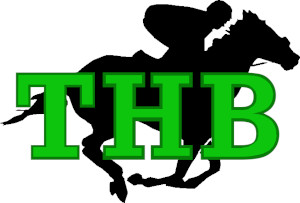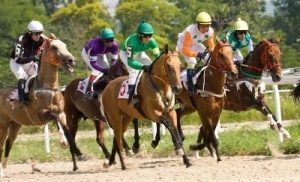In horse racing, average speed ratings (henceforth ASR) are a calculated value assigned to each horse in a race that is meant to indicate how fast the horse ran in relation to the track rating. The higher the ASR, the faster the horse ran.
The goal is to determine if there is statistical evidence for or against the assertion that a horse’s ASR has an impact on its win betting odds in thoroughbred racing
What is an Average Speed Rating?
An average speed rating is a single number that attempts to express the Beyer Speed Figure for a horse’s past performances in a race. The number itself has no meaning – it is simply a relative number used to compare one horse to another. For example, if horse A has an average speed rating of 100 and horse B has an average speed rating of 97, you can assume that, on average, horse A will run three points faster than horse B over a given distance.
There are many factors that go into creating an average speed rating, but the two most important are the Beyer Speed Figure and the final time of the race.
The Beyer Speed Figure is a complex mathematical formula created by renowned researcher Andrew Beyer that attempts to rate the performance of a horse based on both time and competition. Basically, it tries to answer the question “how fast did this horse run considering the track surface, race length, competition level, etc.”
The final time of the race is also taken into account because, all things being equal, a horse that runs a given distance in a shorter amount of time will likely be faster than one that takes longer to complete the same distance.
The Beyer Speed Figure and final time are combined and weighted to create an average speed rating. This number is then used to compare different horses in order to better assess their relative speeds.
Average speed rating is one of the statistics in the Daily Racing Form for good reason!
How are Average Speed Ratings Calculated?
Average Speed Rating (ASR) is a number assigned to each horse in a race that represents the horse’s average speed over a specific distance during its most recent performances. The ASR is expressed in terms of a horse’s pace, which is the number of seconds it takes the horse to travel 1/8 of a mile. For example, if a horse has an ASR of 100, it means that the horse has averaged 100 seconds per 1/8 mile over its most recent performances.
ASRs are based on data from computerized timing systems that are used to track each horse’s time at different points along the racecourse. These systems use sensors placed around the track to record each horse’s time at predetermined intervals, such as every 1/8 mile. This data is then used to calculate the horse’s average speed for the race.
The ASR is one of several factors that can be used to handicap a horse race. However, it is important to note that the ASR is not a perfect predictor of how fast a horse will run in any given race. There are many other factors that can affect a horse’s performance, such as the track conditions on race day and the horses’ post positions. Nonetheless, the ASR can be a useful tool for handicappers who are trying to identify potential winners in a race.
How do Average Speed Ratings Impact Horse Betting Odds?
The answer to this question is not as simple as a yes or no. There are many factors that come into play when determining how average speed ratings impact horse betting odds. Some of these factors include the track conditions on the day of the race, the level of competition in the race, and the horse’s past performance.
That being said, there are some general trends that can be observed when looking at how average speed ratings can change the odds in horse races.
In general, horses with higher average speed ratings are more likely to win races than those with lower average speed ratings. This is especially true if the race is run on a fast track. On slower tracks, the difference between high and low average speed ratings is not as pronounced.
In races with a higher level of competition, horses with higher average speed ratings tend to fare better than those with lower ratings. This is likely because these horses have shown they can compete at a higher level and are more likely to win against tougher competition. In races with lower levels of competition, average speed rating is not as important and other factors such as past performance and jockey ability become more important.
Overall, average speed rating is just one factor that can impact horse betting odds. Other factors such as track conditions, level of competition, and past performance also play a role in determining a horse’s chances of winning a race.
Is ASR Predictive Odds-Wise?
After analyzing the data, it does not seem that average speed ratings have a significant impact on horse betting odds. Statistical studies have shown no correlation between the two variables, and the p-value is generally greater than 0.05. Therefore, we can conclude that the null hypothesis is true and that average speed ratings do not have an impact on horse betting odds.
This video describes different speed figures and their predictive ability for betting on horse races:
About Different Speed Ratings – Q&A
How does speed index work in horse racing?
The three quickest winning times at a certain distance over the previous three years at a specific track are used to compute the speed index. The total of these times is averaged, and the result is the 100 Speed Index for that distance on that track.
How accurate are horse racing odds?
The odds provided by bookmakers assess the likelihood that, for example, a horse will win a certain race. And if they were trustworthy, around 50% of horses with even odds would triumph, followed by approximately 33% of those with 2-1 odds, 1% of “long shots” with chances of 100-1, and so on.
Horse racing odds are mainly determined by two factors: the initial show from the bookmakers and the volume of market money. You will see the odds that are “right” at that precise moment – a snapshot in time. Odds constantly change.
What is a good speed index for a quarter horse?
In general, any speed index above 90 is outstanding, and only the best sprinters surpass the 100 barrier.
What is a good Beyer speed rating?
The best stakes horses in the U.S. and Canada score in the 100s on the Beyer scale, and outstanding performances may score in the 120s or higher.
What is BSF in horse racing?
The BSF method, developed by Andy Beyer, is used in North America to evaluate the performance of horses. The total represents both the length of the race and the natural pace of the track that it was raced over. This gives us the chance to evaluate how horses fared on various tracks on various days.
How are Racing Post Ratings (RPR) calculated?
Racing Post Ratings (RPR) are based on a horse’s performance in a race in proportion to the weight it is carrying; for example, if horse X wins a race while carrying the same weight as horse Y, it will be given a better rating. Since the ratings are given in pounds (lb), a horse with a rating of 140 is seen to be 10 lb superior than one with a rating of 130.
What is a good speed figure for a horse?
A horse who can run speed figures of 80 or greater would have a strong chance of winning any race with a class rating of 80 as the class rating may be seen as the par speed number for the event. Consider a horse’s most recent speed rating or the average of its previous ratings to contrast with the current class rating.
What does the Equibase speed figure mean?
Speed Figure from Equibase® provides a single statistic that indicates the average speed of a horse during its previous races. Its complex calculations are based on the horse’s real time along with other elements including the track’s condition.
What does TS and RPR mean in horse racing?
TS is short for Top Speed which denotes how quickly a horse can go.
RPR is short for Racing Post Rating, which represents a horse’s performance in a race in proportion to the weight it is carrying
Does weight matter to speed ratings in horse racing?
Simply said, absolutely. To ensure that a horse’s racing betting chances are favorable, weight is either added to or subtracted from it. A horse’s odds will decrease if they are in poor shape and have a low OR going into a race since they are likely to weigh less than their competitors.
How do handicappers rate horses?
The racing style of each horse is classified by pace handicappers, who then look for contenders depending on the anticipated speed of the current race. The challenge is that the jockey has influence over a horse’s starting position and the early pace of the race.
What is average distance in horse racing?
Thoroughbreds and Quarter Horses both run at speeds of little over 40 miles per hour on average during a race. Racing distances for quarter horses are measured in yards, and they usually run events between 220 yards (one furlong, or 0.125 miles) to 770 yards (three and a half furlongs, or 0.4375 miles).
What is class rating in horse racing?
Based on the horses’ individual Speed Figures before to each race, class ratings are calculated using expected finishing timings.
How often do high odds horses win?
This table below gives you expected returns for different high odds in horse racing.
| Odds Range | Expected Return |
| 1/100 to 2/5 | 104.6% |
| 4/9 to 3/5 | 99.3% |
| 8/11 to 1/1 | 92.3% |
| 21/20 to 3/2 | 90.8% |
| 13/8 to 9/4 | 90% |
| 9/2 to 9/1 | 89% |
The “horse racing class chart” is a chart that shows what the average speed is for each horse in the race. This can be used to see if there are any horses with a faster or slower average speed than others.
Related Tags
- timeform speed ratings
- horse racing speed charts
- horse racing speed ratings free
- how to calculate horse speed ratings
- what is a good equibase speed figure

I am Lawrence (aka “The Horse Better”). I spent 20+ years in financial risk management where I ran large-scale statistical betting models in complex situations. I grew up around horses and I’ve been betting on horse races for about 10 years with good success. I hope my articles provide good value!

